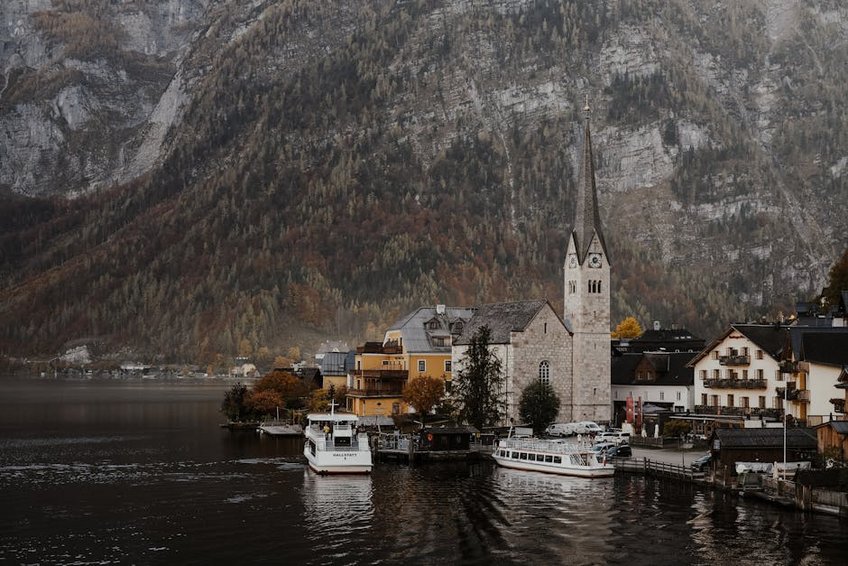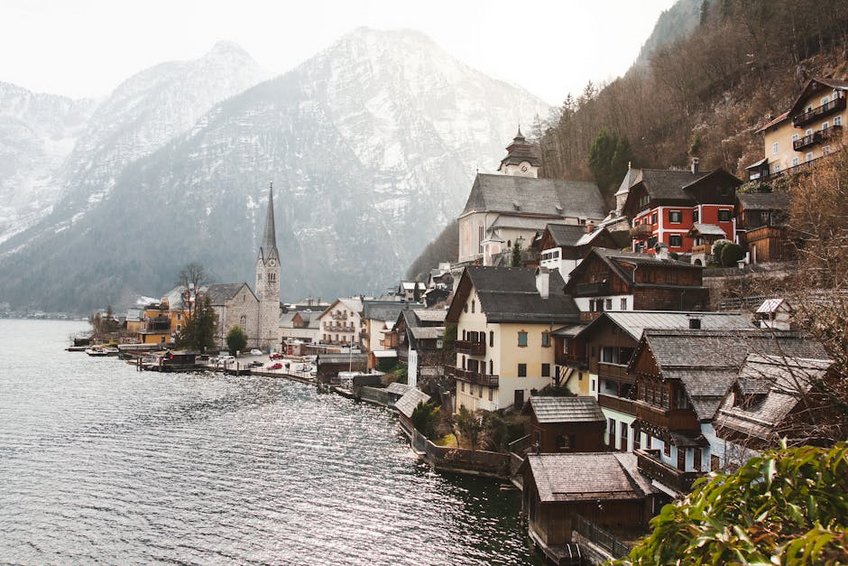Discover the Enchanting Austria Hallstatt Lakeside Village
Nestled between the towering Dachstein Mountains and the serene Hallstätter See, the Austria Hallstatt Lakeside Village offers a picture-perfect escape that feels like stepping into a fairy tale. You’ll find yourself mesmerized by the charming pastel-colored houses reflecting in the crystal-clear waters, the ancient salt mine history dating back thousands of years, and the peaceful atmosphere that makes this UNESCO World Heritage site a bucket-list destination for travelers worldwide. Whether you’re planning a romantic getaway, a family adventure, or a solo retreat, Hallstatt provides an unforgettable experience with its blend of natural beauty, rich cultural heritage, and outdoor activities. From leisurely boat rides on the lake to exploring the world’s oldest salt mine, every moment in this Austrian gem promises new discoveries. The Austria Hallstatt Lakeside Village has captivated visitors for centuries with its unique combination of alpine scenery and lakeside tranquility, making it one of Europe’s most photographed and beloved destinations. You’ll appreciate how this small village manages to offer big experiences, from hiking trails with breathtaking views to cozy cafes serving traditional Austrian pastries.
Austria Hallstatt Lakeside Village – Essential Information
Before you pack your bags for the Austria Hallstatt Lakeside Village, understanding its foundational aspects will enhance your travel experience significantly. This picturesque village sits in Austria’s Salzkammergut region, approximately 50 miles east of Salzburg, and has been inhabited since prehistoric times due to its rich salt deposits. Hallstatt’s history spans over 7,000 years, earning it UNESCO World Heritage status in 1997 for its cultural landscape that demonstrates early human settlement and industrial activity. The village’s name itself derives from the Celtic word “hall” meaning salt, reflecting its economic importance throughout the ages. You’ll discover that despite its small size—covering just about 60 square kilometers—Hallstatt packs immense cultural and natural wealth, with a permanent population of around 800 residents who maintain traditional Austrian customs and architecture. The climate here is typical of the Alpine region, with cold winters perfect for nearby skiing and mild summers ideal for lakeside activities, though microclimates can create sudden weather changes that add to the area’s dramatic appeal.
What is Hallstatt and Why Should You Visit?
- Hallstatt represents one of Europe’s oldest continuously inhabited settlements, offering a living museum experience where you can walk through centuries of history while enjoying modern comforts and amenities.
- The village provides stunning photographic opportunities at every turn, from the classic postcard view from the lakeshore to the panoramic perspectives from the Salzberg funicular, making it a paradise for Instagram enthusiasts and professional photographers alike.
- You’ll experience authentic Austrian culture through seasonal festivals, traditional music events, and local craftsmanship, including handmade Christmas ornaments and salt-based products that make perfect souvenirs.
- Budget travelers can manage with approximately $70-100 USD per day by staying in nearby towns like Obertraun, using public transportation, preparing some meals, and focusing on free activities like lakeside walks and village exploration.
- Mid-range visitors spending $150-250 USD daily will enjoy comfortable hotels in Hallstatt itself, restaurant meals featuring local cuisine, guided tours of the salt mine, and boat rentals on the lake for a more immersive experience.
- Luxury experiences at $300-500+ USD per day include five-star heritage hotels with lake views, private guided tours, fine dining at gourmet restaurants, and special activities like paragliding over the Alps or private boat charters.
- Official Hallstatt Tourism Information
- UNESCO World Heritage Centre – Hallstatt-Dachstein
Historical Significance and UNESCO Status Details
Hallstatt’s UNESCO designation recognizes its exceptional universal value as a cultural landscape that illustrates human interaction with the environment over millennia. The Hallstatt Period (800-450 BCE) in European prehistory is named after this village due to archaeological discoveries that revealed advanced Iron Age civilization. You can explore this history firsthand at the Hallstatt Museum, which houses artifacts from the prehistoric cemetery and demonstrates how salt mining shaped regional development. The village’s architecture reflects various historical influences, from Gothic churches to Baroque details, all preserved through careful conservation efforts. Visiting the Beinhaus (Bone House) in St. Michael’s Chapel offers a unique glimpse into local burial traditions, where painted skulls commemorate generations of villagers, showcasing a profound cultural practice that continues to fascinate anthropologists and travelers.
Austria Hallstatt Lakeside Village – Planning Your Trip
Strategic planning ensures you make the most of your visit to the Austria Hallstatt Lakeside Village, balancing must-see attractions with hidden local experiences. You’ll want to consider seasonal variations carefully—spring brings blooming flowers and fewer crowds, while autumn offers spectacular foliage colors reflected in the lake’s mirror-like surface. Budget-conscious travelers will appreciate that Hallstatt offers options for various spending levels, from affordable guesthouses to luxury hotels with lake views, though advance booking is essential year-round due to high demand. Your preparation should include comfortable walking shoes for exploring the village’s cobblestone streets, layered clothing for changeable mountain weather, and a camera to capture the unforgettable scenery. Many visitors combine Hallstatt with other Austrian destinations like Salzburg or Vienna, but the village deserves at least two full days to appreciate its relaxed pace and numerous activities properly.
Best Time to Visit Hallstatt Lakeside Village
The ideal time for experiencing Austria Hallstatt Lakeside Village depends largely on your preferred activities and tolerance for crowds. Summer months (June-August) offer warm weather perfect for swimming in the lake and longer daylight hours for hiking, but you’ll encounter peak tourist numbers and higher accommodation prices. Shoulder seasons—late April to early June and September to October—provide a wonderful balance with pleasant temperatures, vibrant natural colors, and fewer visitors, making photography and peaceful exploration more enjoyable. Winter transforms Hallstatt into a magical snow-covered wonderland between December and February, with Christmas markets adding festive charm, though some attractions may have reduced hours. Regardless of when you visit, early morning and late afternoon hours typically see fewer day-trippers, allowing you to experience the village’s tranquil atmosphere more authentically.
Budget Planning and Costs for Your Hallstatt Trip
Essential Preparation Checklist Before You Go
Proper preparation significantly enhances your Austria Hallstatt Lakeside Village adventure, starting with securing accommodations several months in advance, especially for summer visits or holiday periods. You’ll need to check visa requirements—fortunately for US and EU passport holders, Austria permits visa-free stays up to 90 days within the Schengen Area. Pack versatile clothing suitable for layering, as mountain weather can shift rapidly from sunny to rainy, and include sturdy footwear for exploring uneven terrain and hiking trails. Don’t forget European electrical adapters for your devices, though most hotels provide them, and consider purchasing travel insurance that covers outdoor activities and potential weather disruptions. Learning a few basic German phrases will enrich your interactions with locals, though English is widely spoken in tourist areas, and having both cash (Euros) and credit cards ensures smooth transactions throughout your stay.

Austria Hallstatt Lakeside Village – Top Attractions and Activities
Your exploration of Austria Hallstatt Lakeside Village reveals countless treasures beyond the iconic lakeside view that makes this destination famous. The Hallstatt Skywalk “Welterbeblick” offers a breathtaking panoramic perspective 350 meters above the village, accessible via the Salzberg funicular, where you can see the entire Hallstätter See basin and surrounding Dachstein glaciers. Beneath the surface, the Hallstatt Salt Mine—considered the world’s oldest—provides fascinating underground tours that include wooden slides used by miners centuries ago and an underground salt lake illuminated for dramatic effect. You can rent electric boats or join guided boat tours to experience the village from the water, providing completely different vantage points of the historic buildings clinging to the mountainside. For active travelers, numerous hiking trails range from gentle lakeside paths to challenging alpine routes leading to Five Fingers viewing platform, each offering unique perspectives of this spectacular landscape.
Must-See Highlights in Hallstatt Village
No visit to Austria Hallstatt Lakeside Village is complete without experiencing its signature attractions, starting with the Market Square (Marktplatz), where you’ll find charming cafes, traditional guesthouses, and the iconic Protestant Church with its slender spire featured in countless photographs. The Catholic Parish Church of Hallstatt, dating to the 15th century, houses beautiful late Gothic altars and offers access to the famous Charnel House (Beinhaus) containing over 1,200 painted skulls—a unique cultural tradition. You should allocate at least half a day for the Salt Mountain (Salzberg) experience, combining the funicular ride, skywalk, and salt mine tour for a comprehensive understanding of Hallstatt’s historical significance. The World Heritage Museum provides excellent context with archaeological finds and exhibits explaining the village’s 7,000-year history, while simply wandering the narrow lanes reveals hidden courtyards, traditional fountains, and artisan workshops that capture the village’s authentic character.
Hidden Gems and Local Favorites Around Hallstatt
Beyond the well-trodden tourist paths, Austria Hallstatt Lakeside Village conceals several lesser-known treasures that offer more intimate experiences. The Echern Valley (Echerntal) trail leads to stunning Waldbachstrub Waterfall and mysterious Gletschergarten glacier gardens, providing peaceful hiking alternatives to crowded main routes. Local fishermen often gather at the Seelände promenade during early mornings, where you can observe traditional boats and sometimes purchase freshly caught fish directly from the lake. The Rudolfsturm medieval tower, originally built as a defensive structure, now houses a restaurant with spectacular views and fewer visitors than the main skywalk. For a truly unique perspective, consider visiting the Hallstatt Bone House during quieter hours or exploring the backstreets uphill from the main square, where you’ll discover beautifully preserved traditional houses and gardens that most day-trippers miss entirely.
Austria Hallstatt Lakeside Village – Practical Travel Information
Navigating Austria Hallstatt Lakeside Village requires some practical knowledge to maximize your comfort and enjoyment during your stay. The village is car-free for non-residents during peak hours, with parking available in designated lots outside the center (approximately $10-15 USD daily), making the efficient foot ferry from the train station or parking areas your best arrival option. Accommodation ranges from family-run guesthouses to luxury hotels, with many properties offering stunning lake views but requiring advance reservations—sometimes up to a year for peak seasons. You’ll find that most services concentrate around the Market Square, including restaurants, souvenir shops, and information centers, while the post office and supermarket provide essential supplies. The compact size means everything is walkable, though comfortable shoes are essential for the village’s steep pathways and staircases connecting different levels of the settlement.
| Category | Options/Features | Price Range (USD) |
|---|---|---|
| Accommodation | Guesthouses, Heritage Hotels, Apartments | $80-400 per night |
| Dining | Traditional Austrian, International, Cafes | $15-50 per person |
| Activities | Salt Mine Tour, Funicular, Boat Rental | $20-100 per activity |
| Transportation | Train, Bus, Ferry, Rental Car | $5-50 per journey |


